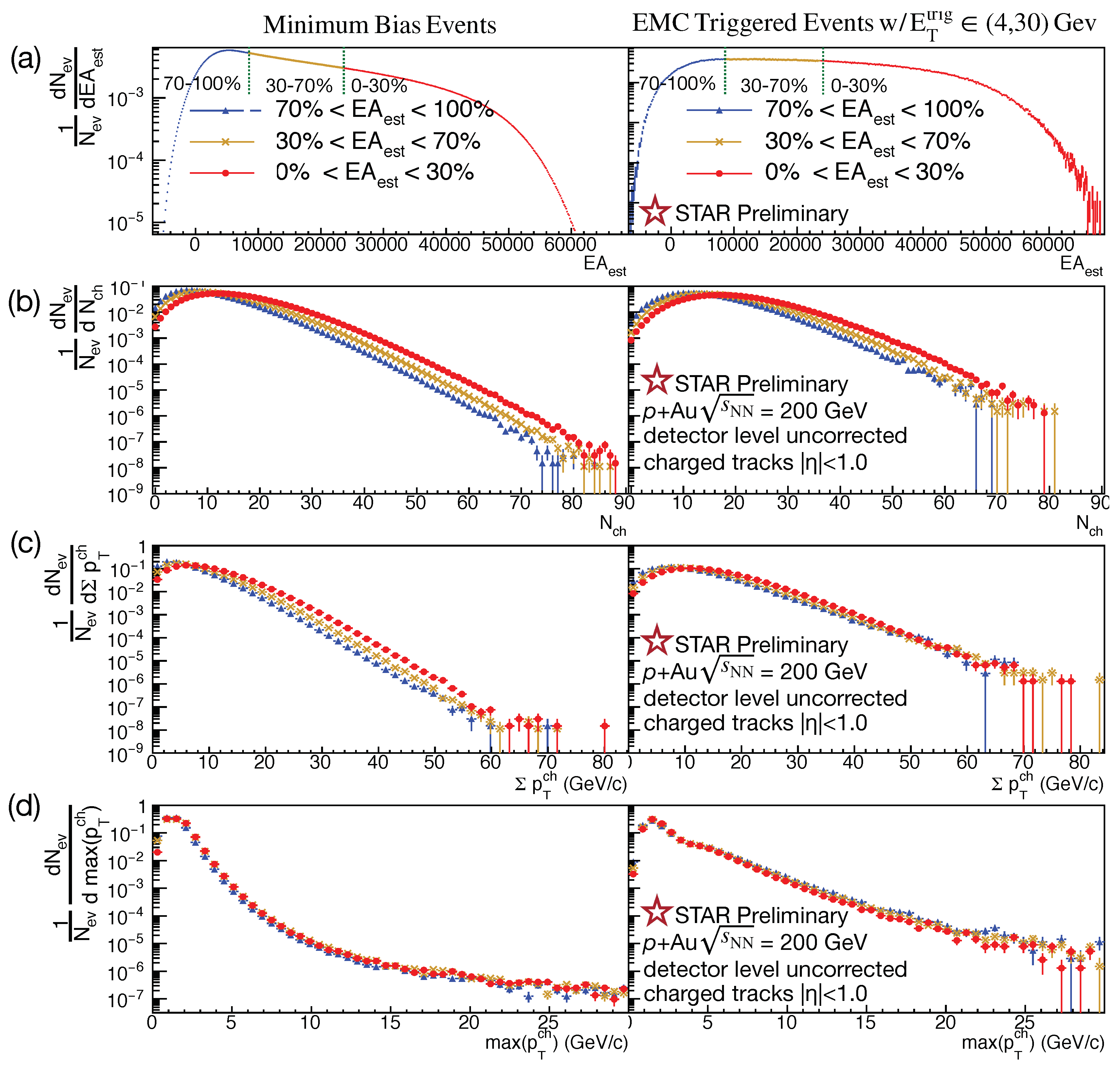Event Activity Measurements and Mid-Rapidity Correlations in 200 GeV pAu Collisions at STAR †
Abstract
:1. Introduction
2. Event Activity Estimation and Correlations to
3. Correlations of to Mid-Rapidity Charged Tracks at STAR for p+Au Collisions
4. Summary
Funding
Conflicts of Interest
References
- David, G. Centrality Issues in Asymmetric Collisions: Direct Photons to the Rescue? PoS 2017, INPC2016, 345. [Google Scholar] [CrossRef]
- Adam, J.; Adamová, D.; Aggarwal, M.M.; Rinella, G.A.; Agnello, M.; Agrawal, N.; Agrawal, N.; Ahammed, Z.; Ahmad, S.; Ahn, S.U.; et al. Centrality dependence of charged jet production in p–Pb collisions at . Eur. Phys. J. 2016, C76, 271. [Google Scholar] [CrossRef] [PubMed]
- CMS Collaboration. Measurement of inclusive jet production and nuclear modifications in pPb collisions at . Eur. Phys. J. 2016, C76, 372. [Google Scholar] [CrossRef]
- Aad, G.; Abbott, B.; Abdallah, J.; Khalek, S.A.; Abdinov, O.; Aben, R.; Abi, B.; Abolins, M.; AbouZeid, O.S.; Abramowicz, H.; et al. Centrality and rapidity dependence of inclusive jet production in proton-lead collisions with the ATLAS detector. Phys. Lett. 2015, B748, 392–413. [Google Scholar] [CrossRef]
- Adare, A.; Aidala, C.; Ajitanand, N.N.; Akiba, Y.; Al-Bataineh, H.; Alexander, J.; Alfred, M.; Angerami, A.; Aoki, K.; Apadula, N.; et al. Centrality-dependent modification of jet-production rates in deuteron-gold collisions at . Phys. Rev. Lett. 2016, 116, 122301. [Google Scholar] [CrossRef] [PubMed]
- Adam, J.; Adamová, D.; Aggarwal, M.M.; Aglieri Rinella, G.; Agnello, M.; Agostinelli, A.; Agrawal, N.; Ahammed, Z.; Ahmed, I.; Ahn, S.U.; et al. Centrality dependence of particle production in p-Pb collisions at . Phys. Rev. 2015, C91, 064905. [Google Scholar] [CrossRef]
- Bzdak, A.; Skokov, V.; Bathe, S. Centrality dependence of high energy jets in p+Pb collisions at energies available at the CERN Large Hadron Collider. Phys. Rev. 2016, C93, 044901. [Google Scholar] [CrossRef]
- Armesto, N.; Gülhan, D.C.; Milhano, J.G. Kinematic bias on centrality selection of jet events in pPb collisions at the LHC. Phys. Lett. 2015, B747, 441–445. [Google Scholar] [CrossRef]
- Kordell, M.; Majumder, A. Jets in d(p)-A Collisions: Color Transparency or Energy Conservation. Phys. Rev. 2018, C97, 054904. [Google Scholar] [CrossRef]
- Acharya, S.; Adamová, D.; Adolfsson, J.; Aggarwal, M.M.; Rinella, G.A.; Agnello, M.; Agrawal, N.; Ahammed, Z.; Ahn, S.U.; Aiola, S.; et al. Constraints on jet quenching in p-Pb collisions at measured by the event-activity dependence of semi-inclusive hadron-jet distributions. Phys. Lett. 2018, B783, 95–113. [Google Scholar] [CrossRef]
- Adam, J.; Adamová, D.; Aggarwal, M.M.; Rinella, G.A.; Agnello, M.; Agrawal, N.; Ahammed, Z.; Ahn, S.U.; Aimo, I.; Aiola, S.; et al. Measurements of jet quenching with semi-inclusive hadron+jet distributions in Au+Au collisions at . Phys. Rev. 2017, C96, 024905. [Google Scholar] [CrossRef]


Publisher’s Note: MDPI stays neutral with regard to jurisdictional claims in published maps and institutional affiliations. |
© 2019 by the author. Licensee MDPI, Basel, Switzerland. This article is an open access article distributed under the terms and conditions of the Creative Commons Attribution (CC BY) license (https://creativecommons.org/licenses/by/4.0/).
Share and Cite
Stewart, D., for the STAR Collaboration. Event Activity Measurements and Mid-Rapidity Correlations in 200 GeV pAu Collisions at STAR. Proceedings 2019, 10, 49. https://doi.org/10.3390/proceedings2019010049
Stewart D for the STAR Collaboration. Event Activity Measurements and Mid-Rapidity Correlations in 200 GeV pAu Collisions at STAR. Proceedings. 2019; 10(1):49. https://doi.org/10.3390/proceedings2019010049
Chicago/Turabian StyleStewart, David for the STAR Collaboration. 2019. "Event Activity Measurements and Mid-Rapidity Correlations in 200 GeV pAu Collisions at STAR" Proceedings 10, no. 1: 49. https://doi.org/10.3390/proceedings2019010049
APA StyleStewart, D., for the STAR Collaboration. (2019). Event Activity Measurements and Mid-Rapidity Correlations in 200 GeV pAu Collisions at STAR. Proceedings, 10(1), 49. https://doi.org/10.3390/proceedings2019010049



